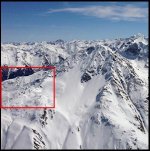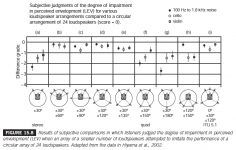Markus,
My sense of spaciousness it doubtless very much the same as yours, and most like everybody's.
You know Magic Eye pictures? Some people can't see them at all. For others it doesn't take much more than a blink to get the image. I fall somewhere in between. My first experience was very protracted and straining. A learning curve was involved. At first maintaining gaze on 3-D images was straining experience and image was easily lost. With practice I can look at these images and blink or close an eye for short periods without loosing the image.
I believe a very similar processing is involved with auditory system, and much as 3-D is perceivable with two eyes and flat image, very 3-D spaciousness may be recovered from stereo recordings.
When looking at Magic Eye picture a mental shifting sensation occurs when image forms and locks in; it has a busy strained quality that resolves into focused attention. I get a very similar sensation when listening to good recordings on good stereo setup. With familiar recordings the shift sensation is short. With poor recordings, and/or poor system setup the busy strained quality persists without resolution to focused attention. Some recordings come across with flat, concise image right off; nothing more comes from them regardless of listening time or system setup.
Does any of this have relevance to way performer feels, or what a composer is trying to convey? Most of the time the answer is a solid no. This is why recorded sound gained popularity from the outset.
In the end it isn't seeing and hearing, it is all about feeling.
My sense of spaciousness it doubtless very much the same as yours, and most like everybody's.
You know Magic Eye pictures? Some people can't see them at all. For others it doesn't take much more than a blink to get the image. I fall somewhere in between. My first experience was very protracted and straining. A learning curve was involved. At first maintaining gaze on 3-D images was straining experience and image was easily lost. With practice I can look at these images and blink or close an eye for short periods without loosing the image.
I believe a very similar processing is involved with auditory system, and much as 3-D is perceivable with two eyes and flat image, very 3-D spaciousness may be recovered from stereo recordings.
When looking at Magic Eye picture a mental shifting sensation occurs when image forms and locks in; it has a busy strained quality that resolves into focused attention. I get a very similar sensation when listening to good recordings on good stereo setup. With familiar recordings the shift sensation is short. With poor recordings, and/or poor system setup the busy strained quality persists without resolution to focused attention. Some recordings come across with flat, concise image right off; nothing more comes from them regardless of listening time or system setup.
Does any of this have relevance to way performer feels, or what a composer is trying to convey? Most of the time the answer is a solid no. This is why recorded sound gained popularity from the outset.
In the end it isn't seeing and hearing, it is all about feeling.
Again, spaciousness (and envelopment) is something stereo can't deliver. It's NOT a binaural reproduction technique. It's 2 speakers at ±30° in a room. It exploits some processes of our binaural hearing system but not all of them. Cues for spaciousness and envelopment aren't encoded in the transmission channel and there's also no technique to do it in a way that is acceptable to the average consumer.
If you like magic eye pictures, here's a real 3D picture I've shot some weeks ago:

You have to use the cross-eyed view method. If you're doing it right, a three dimensional picture will emerge between the left and right one.
If you like magic eye pictures, here's a real 3D picture I've shot some weeks ago:
You have to use the cross-eyed view method. If you're doing it right, a three dimensional picture will emerge between the left and right one.
Attachments
Jeez that 3D pic works very well on the sreen!
You must have been quite high 4000+? Or is that from Auguille du Midi (I was there in 1989)? Aiguille du midi - Chamonix Mont-Blanc Tourist Office : aiguille du midi cable car, Chamonix ski pass
You must have been quite high 4000+? Or is that from Auguille du Midi (I was there in 1989)? Aiguille du midi - Chamonix Mont-Blanc Tourist Office : aiguille du midi cable car, Chamonix ski pass
These pictures always tend to fall into a theatrically "layered" scenery for me - not a 3D continuum. Is that common or just me?

Only if we look at the scene in 3D we can really resolve the depth information in the marked area. 90 % of the people I know would hardly detect the difference in the marked area. 99 % would not get excited about it, for sure.
This added ability to separate things is the main goal for me in listening to stereo. The increased feeling of (some) spaciousness (like in the picture) is a nice complement of course. What the picture doesn't deliver is a feeling of envelopment. How about a soundtrack of the roaring engine?
Rudolf

Only if we look at the scene in 3D we can really resolve the depth information in the marked area. 90 % of the people I know would hardly detect the difference in the marked area. 99 % would not get excited about it, for sure.
This added ability to separate things is the main goal for me in listening to stereo. The increased feeling of (some) spaciousness (like in the picture) is a nice complement of course. What the picture doesn't deliver is a feeling of envelopment. How about a soundtrack of the roaring engine?
Rudolf
These pictures always tend to fall into a theatrically "layered" scenery for me - not a 3D continuum. Is that common or just me?
There's a reason but it would require a lengthy explanation which is probably a bit off topic
What the picture doesn't deliver is a feeling of envelopment.
You just need to make the picture bigger (and present it in a different way to the left and right eye), all necessary cues are there. In stereo reproduction those cues are missing. That's where stereoscopic imagery and stereo differ.
"In stereo reproduction those cues are missing."
- I disagree - they are in a well recorded" 2-ch Blumlein ( or similar) recordings
- I agree, if we concider a "piece" that is recorded and mixed in studio using multichannel mixing. Spaciousness effects may be envolved but artificially.
I have trained my eyes for cross-eyed viewing 30 years ago, for looking at stereoscopic x-rays of teeth! Now it is more difficult because of my varilenses...
- I disagree - they are in a well recorded" 2-ch Blumlein ( or similar) recordings
- I agree, if we concider a "piece" that is recorded and mixed in studio using multichannel mixing. Spaciousness effects may be envolved but artificially.
I have trained my eyes for cross-eyed viewing 30 years ago, for looking at stereoscopic x-rays of teeth! Now it is more difficult because of my varilenses...
"In stereo reproduction those cues are missing."
- I disagree - they are in a well recorded" 2-ch Blumlein ( or similar) recordings
Hello my finish friend!
Unfortunately we are talking here about a very close to "real" experience which does not seem to be obtainable with pure stereo. Why? Take the perfect recording in a perfect setup in an anechoic room. Reverb comes only from two points in space. Does this relate to a natural experience to you? It does not for me.. It is a very precise rendering but not spatially accurate. If it was, multi-channel never would have existed!
Now, add some channels to give the decorelated ambiance at the right angles and delays to add these missing cues. Better isn't it?
We could, potentially, get it passively with good speakers, be it dipole or not, in a very large room, really large like a small auditorium, then the rear, side and ceiling reflections would probably give a reasonable copy of an original event. With adaptive acoustic treatment, possibly of any event..
So, buy a castle, or an old large cinema and stick to stereo, or get a good multi-channel system with a dry room.
I agree. Hearing a really good movie soundtrack with background sound recorded in true 5-channel surround is very realistic, far more than 2-channel can ever be.
But then I never think of recorded music as realistic, for me it's just an abstract - like watching a photograph. In that case 2-channel is just fine.
But then I never think of recorded music as realistic, for me it's just an abstract - like watching a photograph. In that case 2-channel is just fine.
- I disagree - they are in a well recorded" 2-ch Blumlein ( or similar) recordings
In most recordings they are not (it would sound awful) but let's assume we would use two omnidirectional microphones separated by about 20cm (similar to our ears) and use these to record something. Sound from all directions will hit the microphones. Now we play back that recording over speakers. What was once coming from a multitude of directions is now coming only from the direction of the speakers. Such a recording sounds awful. Way too much ambience.
To make matters worse, the signal from the left microphone hits also the right ear and vice versa. We could eliminate that problem by using headphones but the recording still sounds bad and is perceived within our head. What did we miss?
We missed the effect the outer ear has on the sound reaching the eardrums. The outer ear (and head and torso) distorts the incoming sound in a way that is very specific to the direction of the sound source. Outer ear, head and torso act as a spatial encoder.
If we would place a microphone at each eardrum, record that signal and play it back over headphones the recording would sound like the original event because each channel now carries the spatial information our hearing needs to determine where that sound is coming from.
Last edited:
I'd like to expand on two similarities between such stereo pictures and stereo music.You just need to make the picture bigger (and present it in a different way to the left and right eye), all necessary cues are there. In stereo reproduction those cues are missing. That's where stereoscopic imagery and stereo differ.
First:
There has been some excitement about the painted panoramas that Yagedir Asisi exhibited in Germany over the last decade, regarding their convincing liveliness.
Chronology of panoramas - asisi Panorama International
Looking into a picture that has no visible boundary will move you into the scenery much more convincing than the common framed painting can do. The picture does not need to be 360° (omnipolar), but just exceed our field of vision.
Same for convincing hearing panoramas: By widening the stereo panorama significantly beyond the popular 60° field, it becomes exceedingly “realistic”. Ideally it should just reach into the cone of confusion. A field width of ~85° (just covering the complete front wall) works very well for me.
Second:
Whenever I look at those stereo pictures I feel the (futile) urge to move my head sideways to improve the distance cues. Stereo pictures simply lack the parallax to judge distances with any precision. This becomes most evident in pictures that include no objects of inherently known size – like people or houses. Does anyone except Markus really know if the peak in the foreground is 300 m, 600 m or 1,2 km away?
Same applies for stereo listening. It also lacks the possibility to listen to the scene from different angles. Without significant lateral reflections we have almost no cue, how far away the auditory scene really is.
Rudolf
1) Our field of vision is not 360° but our hearing is. Always.
2) If reproduction scale, focal length and stereoscopic base match then the scenery is perceived as real/normal. My mountain picture presents the view of a person with the eyes several meters apart. Normal eye distance is about 65mm. Interestingly there's a limit to our three dimensional perception of the real world. It's about 50m. Watching the mountains from the plane, the scenery is perceived as flat.
2) If reproduction scale, focal length and stereoscopic base match then the scenery is perceived as real/normal. My mountain picture presents the view of a person with the eyes several meters apart. Normal eye distance is about 65mm. Interestingly there's a limit to our three dimensional perception of the real world. It's about 50m. Watching the mountains from the plane, the scenery is perceived as flat.
Considering our 360° hearing ability, the front 120° clearly count more than the rear 120°. Look at Toole Fig. 15.8 with subjective judgements of perceived LEV. The largest single step to improve LEV is in widening the frontal perspective and not in adding rear sources. That's at least how I interprete the diagrams1) Our field of vision is not 360° but our hearing is. Always.
Rudolf
Considering our 360° hearing ability, the front 120° clearly count more than the rear 120°. Look at Toole Fig. 15.8 with subjective judgements of perceived LEV. The largest single step to improve LEV is in widening the frontal perspective and not in adding rear sources. That's at least how I interprete the diagrams
Rudolf
fig (b) and (d) give nearly the same result?
but yes, fig (i) is not an improvement over fig (b).
a lateral reflection is as good subjectively as a rear discrete source? but.. what about delays then?
Considering our 360° hearing ability, the front 120° clearly count more than the rear 120°. Look at Toole Fig. 15.8 with subjective judgements of perceived LEV. The largest single step to improve LEV is in widening the frontal perspective and not in adding rear sources. That's at least how I interprete the diagrams
Rudolf
but why bother at all to improve LEV?
LEV is an important factor in QUALITY of auditoria but even then NOT of all of them
Leo Beranek's paper "Listener Envelopment LEV, Strength G and Reverberation Time RT in Concert Halls" 2010:
In all of the non-shoebox halls, the audience seating extends nearly to the ceiling on one or more of the four sidewall surfaces. Thus, energy is removed there before the reverberant field is established
therefore LEV per se is not a requirement for realistic presentation of a sound source or multiple sound sources whereas ASW/spaciousness is such a requirement
LEV can be a requirement for accurate presentation of a particular recording venue acoustics but then I can't see any other way of doing it right than ambiophonical multi-channel convolution with values of reverberation filters derived from the particular recording venue measurements
Last edited:
Considering our 360° hearing ability, the front 120° clearly count more than the rear 120°. Look at Toole Fig. 15.8 with subjective judgements of perceived LEV. The largest single step to improve LEV is in widening the frontal perspective and not in adding rear sources. That's at least how I interprete the diagrams
Rudolf
If we only look at LEV, then yes. The experiment suggests that "another pair of loudspeakers at angles from ±60° to ±135° perform superbly".
I was talking about the difference in "field of view". Our hearing picks up sounds from everywhere whereas our sense of sight gets "only" the frontal hemisphere.
Even if sounds solely coming from the frontal hemisphere would suffice for realistic music reproduction, stereo still is limited to two single directions, ±30°.
but why bother at all to improve LEV?
therefore LEV per se is not a requirement for realistic presentation of a sound source or multiple sound sources whereas ASW/spaciousness is such a requirement
depends on the music genre. slow, deep symphonic music with huge harmonic developments and less transients begs for more LEV (think Bruckner, late Strauss for example) whilst opera (not wagner!) needs less of it to perceive articulation and attacks better.
In Beranek's book there are some comments from Karajan on the Musikverein and a table showing how transients are buried by the acoustics.
Spaciousness is defined by both ASW and LEV in these books.
I wonder, SL advocates for a reverse LEDE, dry/open back wall behind listener. If the venue LEV is in the recording, and as a fact reverb should come from everywhere in the room, whould it not be better with a dipole setup to have a diffusive/diffractive back wall too if the distance is fairly large, let's say maybe more than 3-4m?
Let's imagine a room with bass traps in all corners if needed, ceiling and floor treated, side walls closest to listener hard and flat maybe angled properly, all the other walls diffusive?
depends on the music genre. slow, deep symphonic music with huge harmonic developments and less transients begs for more LEV (think Bruckner, late Strauss for example)
yes, it sounds better this way but it is NOT a question of realism
Spaciousness is defined by both ASW and LEV in these books.
ok, then simply ASW is a requirement, a sound source needs to have an ASW to sound realistically (call it "spaciousness of a sound source")
Last edited:
Considering our 360° hearing ability, the front 120° clearly count more than the rear 120°. Look at Toole Fig. 15.8 with subjective judgements of perceived LEV. The largest single step to improve LEV is in widening the frontal perspective and not in adding rear sources. That's at least how I interprete the diagrams
Rudolf
Yes, since from Toole p.296:
All combinations of a pair of loudspeakers at ±30° and another pair of loudspeakers at angles from ±60° to ±135° perform superbly (b), (c), (d),
and (e). Avoid ±150° (f), or whatever angle identifi es the spread of the
front loudspeakers.
and
The five-channel arrangement described in ITU-R BS.775-2, shown in (i), performed about as well as any other confi guration.
Four frontal speakers work very well. Matrix stereo with four front speakers may be the way to go
Interesting is that ITU 5.1 layout is no better than average.
- Elias
Interesting is that ITU 5.1 layout is no better than average.
No, that's not what the data shows - are you following in graaf's footsteps?
(Toole, "Sound Reproduction")
Attachments
- Status
- This old topic is closed. If you want to reopen this topic, contact a moderator using the "Report Post" button.
- Home
- General Interest
- Room Acoustics & Mods
- OB speakers and room acoustics

